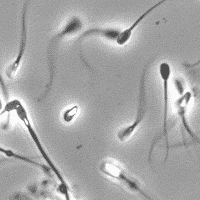Image Analysis of the Motility of Spermatozoa
Spring 2011
Master Semester Project
Project: 00220

The purpose of this project is to develop image-processing tools to perform the computerized analysis of image sequences of spermatozoa acquired through a microscope. We want to measure the motility of the spermatozoa, which gives an index of fertility based on dynamic considerations. The approach will consist of three steps. In the first one, the head of each spermatozoon will be detected, which will result in one set of coordinates per movie frame. The second step will be to link these coordinates together to form tracks, taking the potential existence of detection errors into account, along with the fact that some tracks may come in and out of the field of view. In collaboration with biologists, motion models will be developed to guide the tracking. The last step will be to establish statistics of the trajectories and to summarize them with objective characteristics. The purpose there is to eventually distinguish between different global behaviors such as oriented flow, truly random path, healthy, or unhealthy spermatozoa. The final goal of the biologists is then to manipulate the experimental conditions to discover and quantify how they affect the motility of spermatozoa.
This programming project in Java for ImageJ is a collaboration with the Biomedical Imaging Group, the Centre hospitalier universitaire vaudois, and Biophos AG. A prerequisite is to follow (or to have followed) the course on image processing taught by M. Unser.
This programming project in Java for ImageJ is a collaboration with the Biomedical Imaging Group, the Centre hospitalier universitaire vaudois, and Biophos AG. A prerequisite is to follow (or to have followed) the course on image processing taught by M. Unser.
- Supervisors
- Ricard Delgado-Gonzalo, ricard.delgado@epfl.ch, 021 693 51 43, BM 4.141
- Michael Unser, michael.unser@epfl.ch, 021 693 51 75, BM 4.136